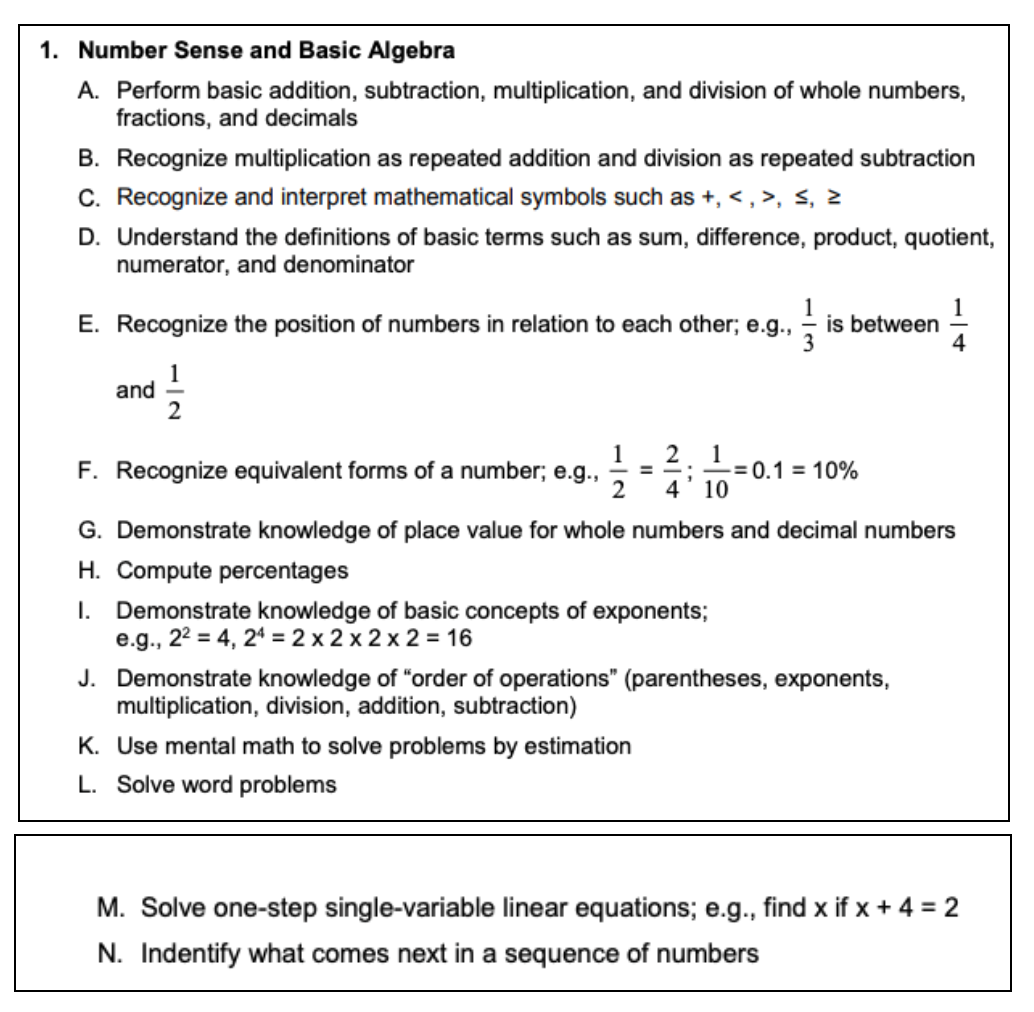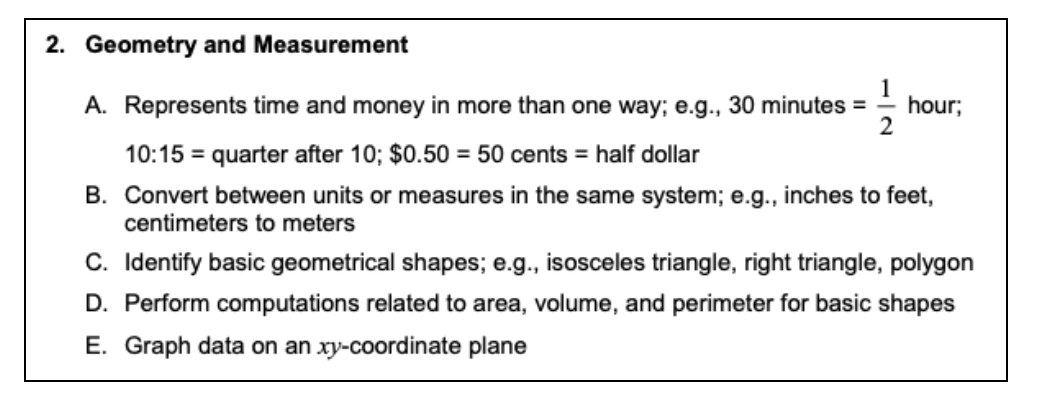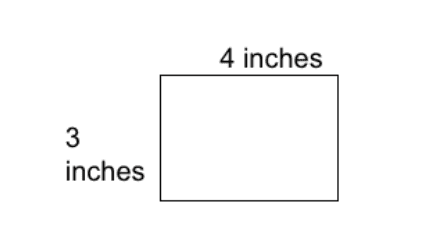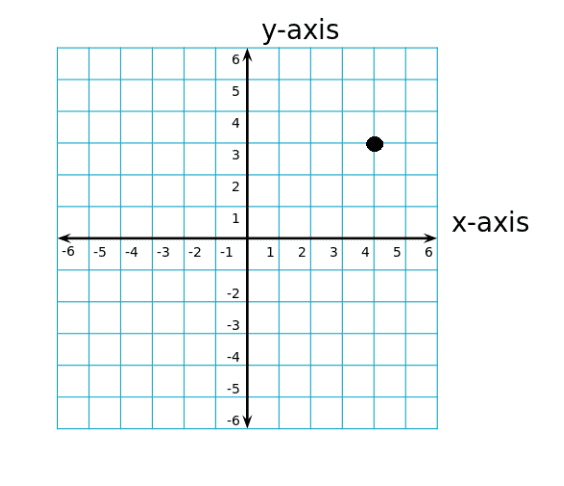GACE Paraprofessional Assessment: Mathematics
Overview
There are about 30 Mathematics questions.
The Mathematics sub-area has two types of questions:
- Mathematics Skills and Knowledge
- Math Application
Mathematics Skills and Knowledge questions include three categories:
- Number Sense and Basic Algebra
- Geometry and Measurement
- Data Analysis
So, let’s start with Number Sense and Basic Algebra.
Number Sense and Basic Algebra

For this section, you will need to understand foundational math skills, as well as some basic algebra.
Let’s discuss some concepts that will more than likely appear on the test.
Place Value
Place value is the value of a digit based on where that digit is in the number. A digit is just a single whole number (0, 1, 2, 3, 4, 5, 6, 7, 8, 9) in a number. For example, the number 29 has two digits (2 and 9). The number 138 has 3 digits (1, 3, and 8).
The place where a digit is located in a number determines its value. A place value chart, such as the one below, can help students understand how many ones, tens, hundreds, etc. are in a number.
For example, the number 4,712 has a 4 in the thousands place, a 7 in the hundreds place, a 1 in the tens place, and a 2 in the ones place. This means there are 4 thousands, 7 hundreds, 1 ten, and 4 ones in this number. The value of the 4 in the thousands place is 4,000 because the digit 4 is actually worth 4,000, not just 4 ones. Models and place value blocks can be helpful when teaching students about place value.
Here is an example of a place value chart for the number 2,356,703:

Exponents
Exponents show how many times to multiply a number by itself. An exponent is a small number located to the right and above a number. An example of a number with an exponent is
3^4. This means that you would multiply 3 by itself four times: 3 x 3 x 3 x 3 = 81. A more detailed explanation is shown below:
3 x 3 x 3 x 3
=9 x 3 x 3
=27 x 3
=81
On the exam, you may be asked to calculate the value of a number with an exponent, identify exponents, or use exponents as a step in the order of operations (explained in the following section).
Order of Operations
The order of operations is the order in which computations must be completed in a math problem. The order of operations is as follows:
- Parenthesis
- Exponents
- Multiplication & Division
- Addition & Subtraction
This means that in a given math expression, anything that is contained within parenthesis must be completed first. After solving the expressions in the parenthesis, you would solve any part of the expression with an exponent. After the exponents, you would solve any multiplication or division portion of the problem, in the order they appear in the problem moving left to right. The last step is to solve any addition or subtraction parts of the problem, again moving left to right.
A common misconception about the order of operations is that multiplication comes before division and addition comes before subtraction. This is not the case. When you are at the multiplication and division step, you will solve whichever one comes first when you read the problem from left to right. The same thing applies to the addition and subtraction step. The order of operations can be remembered by the acronym PEMDAS.
Let’s work an example together:
30 – (7 – 3) x 5 + 4
- (7 – 3) would be solved first, because it is contained within parenthesis. The expression would now be: 30 – 4 x 5 + 4
- There are no exponents in this expression, so you would move on to multiplication and division and solve 4 x 5. The expression would now be: 30 – 20 + 4.
- The next step is addition and subtraction. Since the subtraction occurs first in this problem when reading from left to right, you would do that first. The expression would now be 10 + 4.
- To complete the problem, you would solve 10 + 4 to get an answer of 14.
Geometry and Measurement

For this section, you will need to understand how to measure objects in different ways, recognize various shapes, and graph coordinates onto a coordinate plane.
Here are some concepts that you may see on the test.
Basic Geometrical Shapes
Geometric shapes include shapes such as squares, triangles, rectangles, circles, etc. It also includes additional shapes that are explained below. On the exam, you may be asked to identify certain shapes based on their qualities. Here is some more information on some of the basic geometrical shapes:
Polygon:
A shape with at least 3 straight sides and 3 angles. All of the shapes described below are polygons, along with squares, rectangles, and triangles. A circle is not a polygon, because it does not have 3 straight sides.
Right triangle:
A triangle with a right angle.
Equilateral triangle:
A triangle where all 3 sides are of equal length.
Isosceles triangle:
A triangle with 2 equal sides.
Trapezoid:
A 4-sided shape with only one set of parallel lines. A trapezoid can look like a triangle with the top cut off.
Rhombus:
A shape with 4 straight sides that are all equal length. A rhombus is different from a square because a square has to have 4 right angles, while a rhombus does not.
Pentagon:
Any closed shape with 5 straight sides.
Hexagon:
Any closed shape with 6 straight sides.
Octagon:
Any closed shape with 8 straight sides.
Area
Area is the number of square units inside a 2D shape. In other words, it is the amount of space within a 2D shape. The area of a square or rectangle is found by multiplying the length by the width. For example, the rectangle below would have an area of 12 square inches, because the length is 4 inches and the width is 3 inches: 3 in. x 4 in. = 12 square inches.

To find the area of a triangle, use the following formula:
Area = ½bh
where:
b = base
h = height
This means you would multiply the base of the triangle by the height of the triangle, then take half of that number.
To find the area of a circle, use the formula:
Area = πr²
This means you would first find the square of the radius (by multiplying the radius by itself), then multiply this answer by π, which is about 3.14.
Graphing Data on an XY-Coordinate Plane
A coordinate plane consists of two axes: the x-axis and the y-axis. The x-axis runs horizontally (side to side), while the y-axis runs vertically (up and down). In order to graph a data point on a coordinate plane, you will need to know which axis is which, and which number to use for which axis.
A coordinate is shown as two numbers in parenthesis, divided by a comma. The first number is the x-value and the second number is the y-value. The x-value shows how far over to go on the x-axis. The y-value shows how high up to go on the y-axis. The data point on the graph will be where these two lines meet. The coordinate plane below shows the data point (4, 3). The 4 shows how far over to go on the x-axis, and the 3 shows how far up to go on the y-axis.

Data Analysis

For this section, you will need to know how to read and interpret various types of graphs or tables.
Here are some concepts that you may see on the test.
Mean
Mean is another word for average. In order to find the mean for a set of numbers, you need to find the sum (or total) of all of the numbers, then divide that sum by the amount of numbers or values that are in the data set.
For example, to find the mean of 98, 95, and 83 you would add 98 + 95 + 83 to get 276. You would then divide 276 by 3 because there are 3 different amounts (98, 95, and 93). 276 divided by 3 = 92, so the mean of this set of data is 92.
Median
Median is the middle value when a set of numbers are put in order from least to greatest. If there is an even amount of numbers and two numbers are in the middle, you would find the average of those two numbers.
For example, to find the mean of 34, 33, 38, 37, and 29, you would need to arrange the numbers in order from least to greatest:
29, 33, 34, 37, 38
Since 34 is in the middle, 34 is the median.
The following set of numbers has two numbers that are in the middle:
12, 14, 15, 17, 20, 21
So, you would find the average of 15 and 17 to get a median of 16.
Mode
Mode is the number that appears most frequently in a set of numbers. For example, the mode of the following set of numbers is 18, because it appears 4 times in the set while other numbers appear one, two, or three times:
13, 10, 13, 18, 12, 12, 18, 18, 12, 18
If no number is repeated in a set, then that set of data has no mode.
A set of data can also have more than one mode if more than one number appears most frequently.
Math Application

For this section, you will need to utilize your knowledge of the other math sections to determine how to best help a student or classroom teacher.
And that’s some basic info about the Mathematics sub-area of the GACE Paraprofessional exam.
